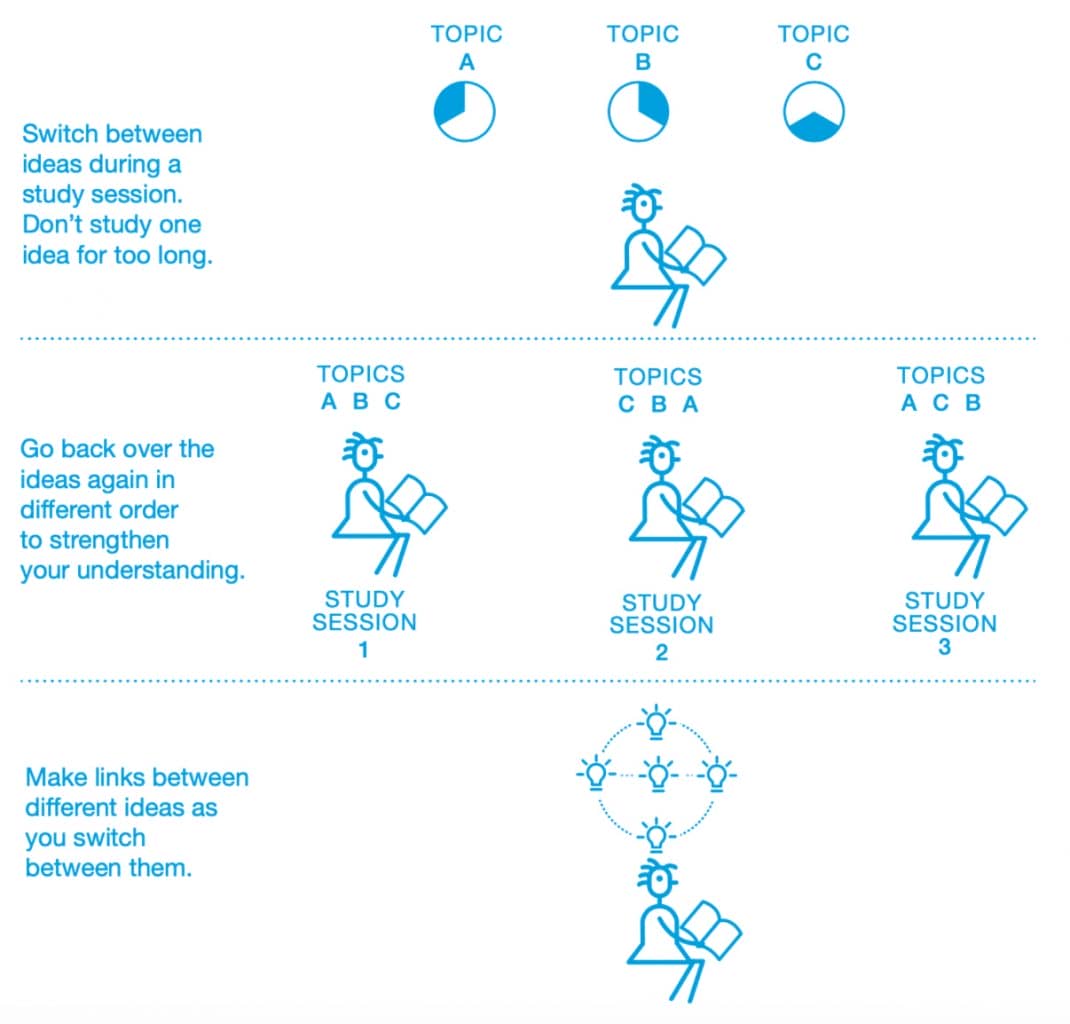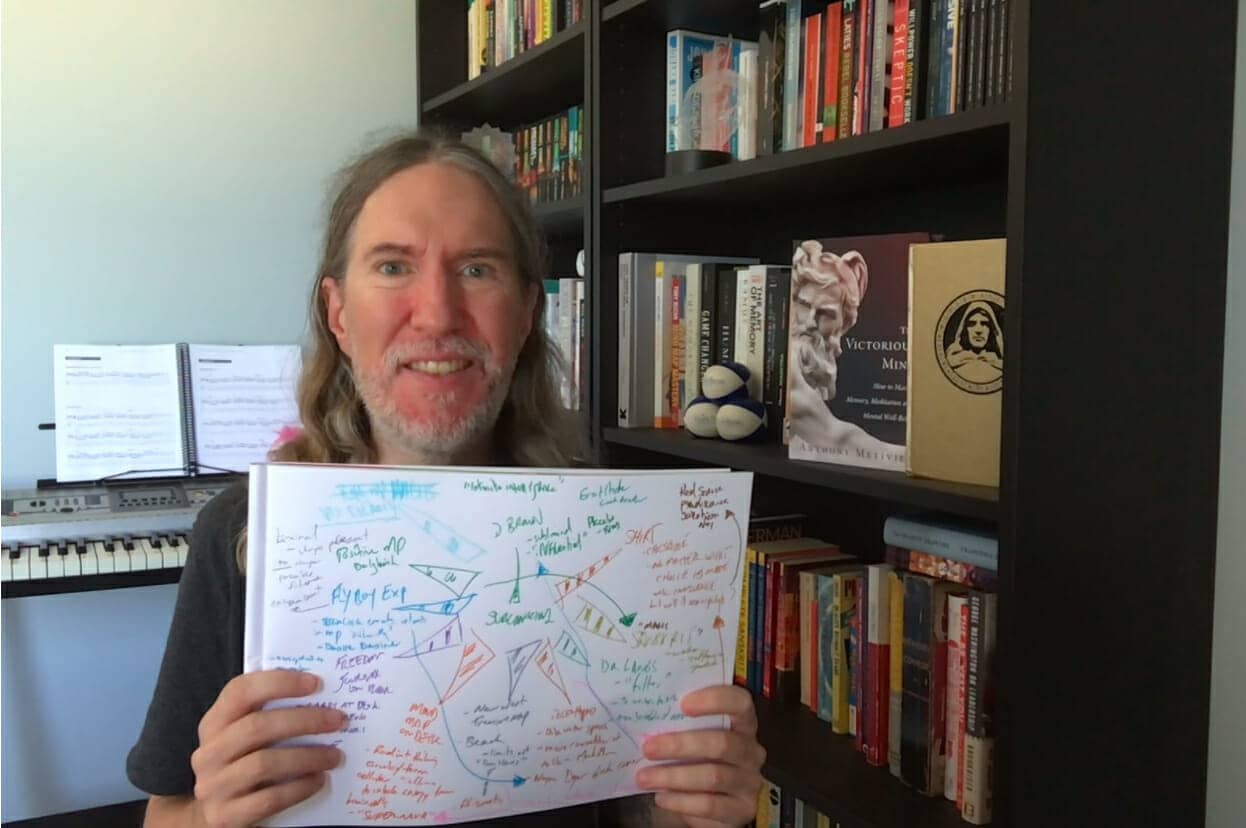
But as with all learning strategies, there is a catch.
Not only is interleaving counterintuitive.
It comes with a certain requirement that will leave some learners shaking their heads.
Please don’t let that stop you, however.
I’ve been using interleaving for decades and it has helped me learn faster and remember more.
Just like the studies predict.
And the requirement for success?
I’ve come to love it, precisely because of how well it works.
Ready to discover the interleaving study method in full and get started yourself?
Let’s dive in!
What Is Interleaving ?
Put simply, interleaving means blocked practice. You switch between 2-5 different learning activities after a small amount of practice.
Musicians provide a concrete example of interleaved practice that will help make how it works clear. Then we’ll look at some steps for using it as a study method for all kinds of topics.
Instead of studying scales for 15 minutes straight, a music student will switch from scales to chords and then arpeggios. By alternating between these different areas of focus for shorter periods of time, both during study and deliberate practice, they are helping the brain form more connections.
In this way, interleaving is an alternative form of timeblocking.
Here’s the counterintuitive part:
Deliberately switching between topics more frequently adds a level of what Diane Persellin et al call “desirable difficulty.”
As they show by citing many scientific studies, focusing on just one topic for a longer period of time makes you feel like you understand more.
In reality, these long periods of focus only create an illusion. When learners switch between topics at regular intervals, they use the information in more contexts. As we know from studies in neuroplasticity, challenging your brain helps you build more neural pathways.
For this reason alone, it makes sense to switch back and forth between multiple topics. The trick is to do it strategically and in combination with other accelerated learning techniques like spaced repetition.
Benefits of Interleaving
In addition to learning faster and remembering more, interleaving helps you:
- Avoid topic exhaustion because you enjoy greater variety
- Take more breaks that encourage reflective thinking
- Greater ability to spot mistakes because you come back at what you’re learning with fresh eyes
- Increased focus and problem-solving abilities
As you’ll see in the next section, you’ll also get the benefit of having skills you’ve learned while interleaving transfer to other activities you regularly perform.
What Does the Research On Interleaving Say?
Researchers regularly find that interleaving works for multiple topics. One study showed that students of physics solved problems much better when using this method.
In another research study, scientists found that learners remembered categories of rocks better in geology and mineralogy. This means that you can expect to get great results even in fields that involve a lot of visual information.
Even better, these researchers found that interleaving provides transfer benefits. This means that if you learn problem solving better in the sciences thanks to interleaving, you’ll likely solve problems with greater effectiveness in other areas of life too.
Interleaved Practice and Blocked Practice: What’s the Difference?
The answer to this question depends on who you ask.
Technically, blocking involves practicing skills individually and in order. In other words, if you are practicing scales, chords and then singing while playing an instrument, you are practicing in an A-B-C pattern, each skill blocked out. Here’s a video example of me blocking out my card practice by moving from shuffling to assembling a memdeck and then finally testing my memory before returning to shuffling in a time-blocked pattern.
Interleaving technically involves practicing scales, then switching to studying from a textbook before returning to chords, then doing some language learning before practicing singing and playing.
Personally, I like to “interleave” these two approaches by sometimes using blocked practice and sometimes using interleaving.
How Is Interleaving Different From Other Learning Methods?
To a certain extent, a lot of interleaving happens naturally. You can only spend so long on any given topic before you’re driven to focus on something else.
Many schools also tend to interleave topics. You spend an hour on biology, then go to language arts before spending on hour on chemistry. By switching to a largely unrelated topic between two hours about science, the brain gets a greater workout.
A main difference between interleaving and other learning methods is that switching between topics often provides results at a later point in the learning cycle.
For example, Doug Rohrer and his research team found that students who did not interleave scored better in the short term. But those students who used an interleaving study method scored better in the long-term.
Because interleaving adds a level of challenge, learners often avoid it. They prefer cramming instead, sometimes in combination with a misunderstood version of chunking. This is tragic, so let’s look next at how you can interleave with greater ease, while also enjoying the benefits of the additional challenge.
How to Apply the Interleaving Study Method to Your Study Sessions
As mentioned, a lot of interleaving happens naturally.
In order to amp up the value of the technique, all you have to do is plan for it and lean into the exact practice strategically.
Fortunately, there are easy and fun guidelines to follow. Here’s the process I’ve been following for decades.
One: Hedge Against Chaos
When you first start interleaving, there’s great risk that you’re just gong to introduce chaos into your learning life.
To avoid this, simply write out your learning goals and schedule your interleaving sessions. I often do my planning in a simple paper journal. Some of my memory competitor friends prefer to use spreadsheets, however.
Either way, planning will make the difference for you. And as you can see from the interleaving diagram below, it’s pretty easy to distribute your study topics across a single week. If just five minutes of planning while help you better remember what you study, isn’t that time well-spent?
Two: Less Is More
When I first heard about interleaving, I spent time using my textbook memorization method on up to a dozen books in a single day.
Because that approach required a lot of skimming and scanning, I don’t do it nearly as much anymore.
Instead, I prefer to rotate between 3-5 books at a time. Likewise with videos and podcasts.
Instead of rotating through too much variety, I find my mind creates stronger links by spending a few weeks or months diving deep into a limited set of topics.
Although I know this type of focus might feel limiting, it’s a behavior I’ve observed in many polymaths. Success, as they say, leaves clues.
Three: Anchor Interleaving To The Best Possible Study Zones
My favorite places to study include libraries and parks.
However, there is no perfect place that suits everyone. You need to explore multiple areas with varying levels of quiet or distraction. Take the time to understand study areas that truly work for you.
When interleaving, having enough desk space is key. You want to be able to use an effective note taking strategy while rotating through different books.
You also want to consider backpack space. Although it seems like a fickle consideration, I learned early on in university that carrying too many books hurt my back.
Keeping pain free is one of the most underrated memory strategies, so please don’t put your body at risk. Having a few dedicated learning spaces where you can store or easily access your textbooks is key.
Likewise, you have to take care with computer exposure. Too much screen time can lead to digital amnesia, or worse.
Four: Use A Variety Of Spaced Learning Techniques
Interleaving isn’t just about intake. It’s also about testing the information you’ve studied.
For this reason, it’s useful to switch between hands-on spaced repetition tools like:
- Zettelkasten
- The Leitner System
- Flashcards
- Anki
- Reviewing your mind maps
Phil Chambers has a great approach to reviewing mind maps in particular that closely resembles interleaving. As you go through your mind map notebook, leave a Roman numeral.
This simple tactic will help you track each review session. And provided that you are mind mapping multiple topics, you’ll be interleaving as you review.
Five: Don’t Completely Eliminate Blocking
As much as I love and have benefitted from interleaving, I still use timeblocking.
For example, I like to interleave between writing and practicing music. But sometimes it’s not helpful to pause when writing a specific book chapter or blog post. Certain projects only get done precisely when timeblocking is in place.
Six: Use Your Hands
Some of the best memory experts reminds us that to learn faster, we need to get our hands involved. I’m talking about people like Lynne Kelly and Tyson Yunkaporta.
Drawing or physically writing out your own flash cards is one way to make sure you’re benefitting from haptic memory using your hands.
And rotating through physical cards in your hands is another. It helps get more of your brain involved and exercises your spatial memory.
Many ancient memory techniques get the hands involved in many ways, so it’s worth learning as much as you can about how our ancestors learned. The Art of Memory is a great source, as are the paper versions of Llull’s Memory Wheels.
Seven: Blast Through Learning Plateaus
Because interleaving provides an extra level of challenge, both when planning for it and applying it to your study sessions, it helps ensure that you don’t have too many learning plateaus.
When you do, interleaving is flexible. You can add another topic to help break through, or reduce your current interleaving practice by one or more topic.
Another aspect here is what some scientists call “discrimination learning.” This effect happens when you are studying related topics and start to confuse them.
It can happen in language learning, math or any of the sciences and creates a kind of plateau. But because interleaving spaces different topics out, you’re better able to discriminate one concept or similar sounding word from the other.
In other words, interleaving helps ensure that some learning plateaus never develop in the first place.That’s yet another counterintuive way interleaving helps you study much faster.
Eight: Interleaving Makes Rewards Easy
All work and no play can make you incredibly dull.
That’s yet another reason why interleaving is such a powerful strategy. You can easily include activities that you love to break up the monotony of dealing with boring topics.
For example, when I’m learning a language from a textbook, I’ll usually have a novel I’m reading for my research. Since I love fiction, it’s like taking a break without taking a break. And having this kind of reward makes it much more likely that I’ll remember what I’m reading across the board. Science suggests that you will too.
Exactly which rewards you’ll choose are up to you. Just make sure to plan everything in advance so that you don’t lead yourself into chaos.
Why Interleaving Learning Is So Effective
Interleaving works for many reasons. A big one is simply that humans respond well to structure and pattern.
And what is approached strategically often becomes automatic, a process governed by procedural memory. It’s part of the reason why using interleaving can become your “go to” study technique.
But interleaving itself is best when used with a variety of techniques and patterns. Here are a few of my favorite:
- Interleaving review of an older study topic with something completely new
- Writing up synthetic summaries comparing and contrasting two topics (like philosophy and religion)
- Consistent self-testing using highly optimized flash cards
- Visiting multiple Memory Palaces devoted to different learning projects
The one I love above all is the Memory Palace technique because it practically has interleaving built into it.
If you’d like to learn more, get my FREE Memory Improvement Kit:
It will help you get the most out of your memory in a strategic way that will quickly become automatic.
That way, whenever interleaving feels a bit challenging, you’ll have a completely fresh way to come at it.
At the end of the way, that’s what advanced learning is all about:
Having a number of tactics and memory techniques in your toolbox.
That way, no matter how challenging learning becomes, you can take a break from the approach you’re using and simply rotate to another one.
That’s what I call learning at “cruising altitude.” The instant you feel even a bit of turbulence, you can instantly correct course.
Want that for yourself? Start interleaving today!
Related Posts
- Stoic Secrets For Using Memory Techniques With Language Learning
Christopher Huff shares his Stoic secrets for using memory techniques when learning a language. You'll…
- The German Professor Who Defends Memory Techniques for Language Learning
This professor defends memorization techniques for learning foreign languages and has the science to prove…
- Memory Techniques For Chinese with Mandarin Blueprint
Mandarin Blueprint provides exceptional material for learning Chinese, including characters, pronunciation and the best memory…










